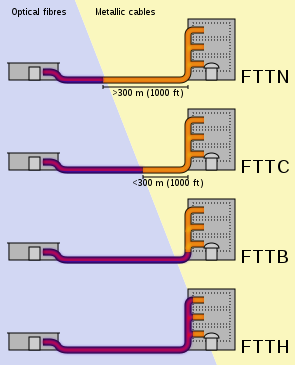Everything you Need to Know About Fiber Optic Internet

Wed, Jun 09, 2021 08:18 AM
A fiber optic line is a more recent type of internet connection. It transmits data by light signals using wires constructed of thin plastic or glass fibers. When compared to more traditional connections like cable, satellite, and DSL, fiber can offer faster speeds and better reliability. When it comes to cost, fiber optic internet is one of the most cost-effective solutions available. It is, however, one of the most difficult to obtain, with distribution confined to a few metropolitan areas and neighborhoods.
Major internet service providers have taken notice of this new connection type. Companies including AT&T, Verizon, Cox, and CenturyLink have hopped on the fiber optic bandwagon to provide customers with higher download and upload speeds.
Because fiber uses light to deliver data, it is far faster than cable's typical copper wire connection. Download rates of up to 1 Gbps are possible with fiber internet, with certain providers, such as Verizon Fios, approaching matching upload speeds. Fiber is soon becoming the gold standard for internet connections due to its fast speeds and comparatively low cost.
Also, Read: Is the Spectrum Gig Internet Plan Worth It?
Types of Fiber Optic Internet
Choosing the right Internet service for your needs when moving to a new location can be tricky. Because of the rapid download and upload speeds, fiber optic internet service can be a fantastic alternative if it is accessible and within your budget. It's capable of transferring big volumes of data in a short amount of time and can scale to meet your evolving internet requirements.
You may have access to one of three types of fiber connections, depending on the location of your new home base: fiber to the neighborhood (FTTN), fiber to the curb (FTTC), or fiber to the home (FTTH).
Also, Read: Comparing Fiber Internet Service In Your Area
Fiber to the Neighborhood (FTTN)
These fiber optic connections make use of wires to send data to a central hub near the house. After there, it may be carried the rest of the way by a different type of cable. The complete network is referred to as a "hybrid fiber-coaxial network" if the company employs DSL or coaxial cable for the last length of transmission to the residence, and internet firms routinely utilize these.
Fiber to the Curb (FTTC)
Fiber to the curb extends the connection beyond the neighborhood, bringing it right to the front door. That is why it is called "to the curb." This connection provides more bandwidth and consistent rates, but it still requires a DSL or coaxial cable for the remainder of the journey into the home.
Fiber to the Home (FTTH)
Fiber to the home extends fiber optic cables all the way to the home, making the network entirely fiber optic. This connection offers the most bandwidth, speeds, and reliability.

Fiber Optic Internet Availability
Only a few major areas and neighborhoods have fiber optic internet. The installation of fiber optic lines is expensive, which explains why acceptance has been gradual. Not only are the cables expensive, but the installation process is time-consuming and labor-intensive.
Another reason why fiber optic internet may take longer to spread than planned is the availability of other solutions. Typically, the target area already has DSL or cable internet connections, which give more than enough speed for most people.
However, fiber optic internet is becoming more widely available. Its fast, symmetrical upload and download rates, as well as the ability to support more bandwidth in the future, give it a lot of traction.
The Pros and Cons of Fiber Internet
Pros of Fiber Internet
There is no way to listen to information coming in or out because there are no wavelengths involved in data transmission via fiber optics. Furthermore, because the hardware is contained in a single location, monitoring and maintenance are simplified and uncomplicated.
Long-term cost-effectiveness: While fiber optic networks are more expensive to establish up front, the scalability options can offset the initial investment.
Higher-quality connections: Electromagnetic interference from an outside source is not a problem with fiber optic internet. This type of disruption can damage the performance of traditional cable connections, but it has no effect on fiber.
Cons of Fiber Internet
Initial expenditures: The high upfront expenses of deploying fiber internet hinder the expansion of this form of connection, limiting its availability.
Fiber Fuse occurs when too much light strikes a flaw in the fiber. Long lengths of cable can be damaged in a short amount of time by a fiber fuse.
Physical Damage: Under some conditions, fiber optics are delicate and delicate. Bend fibers, for example, can decrease performance and make installation problematic.
Featured Plan

Bundles starting from $64.99/mo.
Optimum internet plans offer 1000 Mbps of ultra internet speed with Altice Fibe. You will be able to enjoy 420 plus channels in 4K ultra HD. Optimum is the fourth-largest cable provider in the United States.
View More Deals! (833) 396-32123